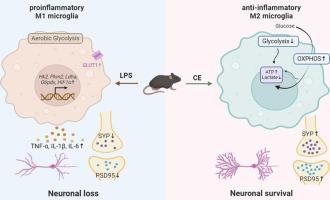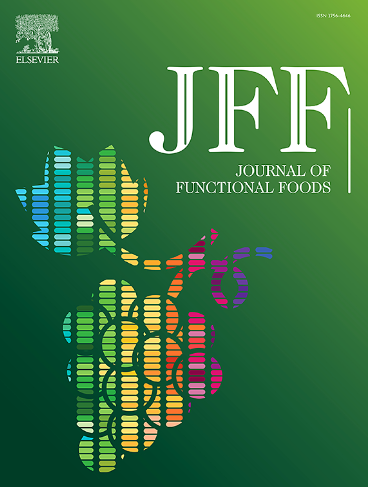Coeloglossum viride var. bracteatum 通过抑制神经炎症和保护突触可塑性减轻脂多糖诱导的小鼠急性抑郁样行为
IF 3.8
2区 农林科学
Q2 FOOD SCIENCE & TECHNOLOGY
引用次数: 0
摘要
小胶质细胞介导的神经炎症和突触损伤是重度抑郁症的发病机制之一。Coeloglossum viride var. bracteatum 提取物(CE)具有抗炎和神经保护作用。因此,我们假设鹅掌楸提取物可以抑制抑郁症的发病机制。为了验证这一假设,我们在脂多糖(LPS)诱导的小鼠模型中评估了 CE 的抗抑郁作用。我们发现,CE 可改善 LPS 诱导的抑郁样表型,如增加小鼠对蔗糖的偏好、减少不动性和改善移动意愿。同时,CE 降低了脑内促炎细胞因子 TNF-α、IL-1β 和 IL-6 的水平。从机理上讲,CE通过抑制有氧糖酵解的增强和改善氧化磷酸化,在HIF-1α/PKM2信号轴的介导下改变了小胶质细胞的表型极化。CE 逆转了突触蛋白、树突棘和神经元丢失的减少。因此,CE可通过抗炎、改变小胶质细胞的能量代谢和保护突触可塑性来缓解LPS诱导的抑郁症,从而凸显其作为抗抑郁药的潜力。本文章由计算机程序翻译,如有差异,请以英文原文为准。

Coeloglossum viride var. bracteatum attenuates lipopolysaccharide-induced acute depressive-like behaviors in mice by inhibiting neuroinflammation and protecting synaptic plasticity
Microglia-mediated neuroinflammation and synaptic damage contribute to the pathogenesis of major depressive disorder. Coeloglossum viride var. bracteatum extract (CE) has anti-inflammatory and neuroprotective effects. Therefore, we hypothesized that CE could inhibit the pathogenesis of depression. To test this hypothesis, we evaluated the antidepressant effects of CE in a lipopolysaccharide (LPS)-induced mouse model. We showed that CE ameliorated LPS-induced depressive-like phenotypes such as increased preference for sucrose, decreased immobility, and improved willingness to move in mice. Consistently, CE reduced the levels of pro-inflammatory cytokines TNF-α, IL-1β, and IL-6 in the brain. Mechanistically, CE transformed the phenotypic polarization of microglia by inhibiting the enhancement of aerobic glycolysis and improving oxidative phosphorylation, mediated by the HIF-1α/PKM2 signaling axis. CE reversed the reduction in synaptic proteins, dendritic spines, and neuronal loss. Thus, CE may alleviate LPS-induced depression through anti-inflammation, alteration of microglial energy metabolism and protection of synaptic plasticity, thus highlighting its potential as antidepressant.
求助全文
通过发布文献求助,成功后即可免费获取论文全文。
去求助
来源期刊

Journal of Functional Foods
FOOD SCIENCE & TECHNOLOGY-
CiteScore
9.60
自引率
1.80%
发文量
428
审稿时长
76 days
期刊介绍:
Journal of Functional Foods continues with the same aims and scope, editorial team, submission system and rigorous peer review. We give authors the possibility to publish their top-quality papers in a well-established leading journal in the food and nutrition fields. The Journal will keep its rigorous criteria to screen high impact research addressing relevant scientific topics and performed by sound methodologies.
The Journal of Functional Foods aims to bring together the results of fundamental and applied research into healthy foods and biologically active food ingredients.
The Journal is centered in the specific area at the boundaries among food technology, nutrition and health welcoming papers having a good interdisciplinary approach. The Journal will cover the fields of plant bioactives; dietary fibre, probiotics; functional lipids; bioactive peptides; vitamins, minerals and botanicals and other dietary supplements. Nutritional and technological aspects related to the development of functional foods and beverages are of core interest to the journal. Experimental works dealing with food digestion, bioavailability of food bioactives and on the mechanisms by which foods and their components are able to modulate physiological parameters connected with disease prevention are of particular interest as well as those dealing with personalized nutrition and nutritional needs in pathological subjects.
 求助内容:
求助内容: 应助结果提醒方式:
应助结果提醒方式:


